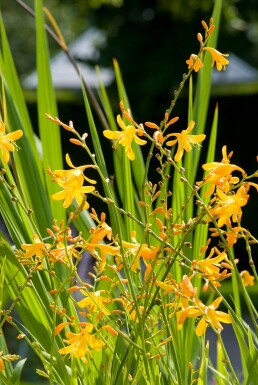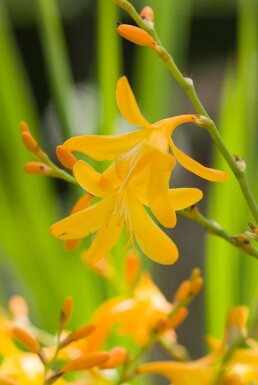

70cm



Updated on 10 September 2025
We regret to inform you that we are currently unable to ship orders to the United Kingdom. We anticipate being able to resume shipments at the beginning of 2026.
Crocosmia adds vibrant colour to gardens with its fiery orange and red blooms, perfect for borders and group plantings. This summer-blooming bulb attracts hummingbirds and butterflies, offering long-lasting flowers and minimal maintenance. Ideal for creating natural, lively borders.


70cm



Crocosmia brings vibrant colour to gardens, especially in summer and autumn. This plant showcases upright fans of vivid red, orange, or yellow tubular flowers, complemented by its sword-shaped leaves. Known for adding a southern flair, Crocosmia thrives in borders and makes a striking cut flower. Imagine these fiery flowers filling late-summer gaps, combining beautifully with ornamental grasses and perennials. Looking to enhance your garden? Consider Crocosmia for its exotic perennial charm and its reputation as a stunning bulbous perennial. Discover how Crocosmia can transform landscapes with its unique appeal and energy. Order Crocosmia corms in the UK and enjoy its captivating presence throughout the seasons.
Crocosmia, also known as montbretia, is a bulbous perennial admired for its fiery flowers and unique arching form. Often called Coppertips or Summer arching perennial, these vibrant flowers bring life to any garden. Montbretia is commonly used in borders, group planting, and pots. They make excellent cut flowers and offer a haven for bees and butterflies. Belonging to the Iridaceae family, Crocosmia is native to South Africa, but its striking colours are cherished in UK gardens. Acting as natural late-summer gap fillers, they add warmth and vibrancy to borders and insect nooks. The name Crocosmia comes from the Greek words 'krokos' meaning saffron and 'osme' meaning scent, referring to the saffron-like fragrance released by dried flowers. It symbolises fire and remembrance, capturing attention with its bright presence. While frost-sensitive, these perennials are fast-growing and attract hummingbirds and insects. Order Crocosmia corms in the UK and enjoy their beauty each year. Consider buy Crocosmia to enhance your garden with their delightful colour ranges and clump spread.
The Crocosmia is a fiery perennial with elegant flower spikes in orange and red. This plant grows upright with bushy, airy flowering forms. Sword-shaped leaves rise from the ground, creating an attractive clump spread. It grows rapidly and reaches heights between 30 cm and 1 m depending on the type. From the moment they sprout, Crocosmias develop quickly. They emerge as small green shoots that soon fan out into graceful leaves. By mid-summer, they produce vibrant flower spikes that sway gently in the breeze. The plants thrive in well-drained soil, and regular watering helps them reach their potential. Crocosmias bloom mainly from July to September. The flowering time can vary with weather and soil conditions. Warmer climates encourage earlier blooming, while cooler temperatures might delay it slightly. The colourful display is most intense with good sunlight and care. Flowers of Crocosmia come in a striking palette, including orange-red, fiery red, yellow, apricot, and bright orange. Soil quality and type can influence the intensity of these colours. Adequate sunlight further enhances the vibrancy of the blooms. While Crocosmias are not renowned for a strong scent, their blooms and leaves add texture and visual interest to any garden. The mature height of these plants can be affected by factors such as location, soil type, and care, allowing them to reach their optimal growth.
Crocosmia leaves have a sword-shaped form, which is both elongated and upright. The leaf colour ranges from fresh green to light green, adapting to various conditions. Crocosmia is moderately hardy, surviving in temperatures as low as -18°C to -12°C. The plant is frost-sensitive but can endure winter with mulch cover, suitable for USDA zones 6 to 8. It typically retains its leaves, yet may drop them during dry conditions to conserve moisture. Originating from warmer climates, Crocosmia is heat and drought-tolerant. Its tuber stores moisture, and the plant thrives in well-drained soil, showing resilience under wind exposure. Importantly, Crocosmia is non-toxic, posing no danger to children or pets, making it a safe addition to any garden. For biodiversity, Crocosmia blooms from July to September in vivid fiery colours like orange and red. These flowers attract pollinators and support garden ecosystems by providing food and shelter. Consider planting Crocosmia corms in the UK garden or dividing overcrowded plants to enhance space. During colder months, it is recommended to lift and store the tubers to ensure a healthy perennial return in the spring.
Crocosmia is a vibrant addition to any garden, known for its fiery flowers that bloom in late summer. This bulbous perennial can transform any space with its striking colours and unique shapes. Here are some inspiring ways to incorporate Crocosmia into the garden:
For those looking to enhance their garden with montbretia, this plant offers fiery flowers and an exotic touch. A perfect bulbous perennial for those wanting to buy montbretia and add a unique element to their spaces. It's versatile and can be combined with various plants, providing endless possibilities for garden creativity. Consider Crocosmia for a vibrant, lively addition to the garden scene.
Crocosmia is a stunning addition to any garden, known for its vibrant orange-red flowers and summer blooms. This exotic perennial pairs beautifully with various plants, creating a lively and eye-catching display. Crocosmia adds fiery colour highlights and belongs among other flowering garden plants. Combining Crocosmia with ornamental grasses like Miscanthus provides a lovely contrast, as the soft, swaying grass complements the bold colours of Crocosmia. Kniphofia, with its striking torch-like flowers, enhances the fiery palette, creating an impressive border display. Rudbeckia offers a golden touch to the garden, balancing Crocosmia’s bold hues with its sunny yellow flowers. Salvia's purple spikes introduce a cool colour contrast, making the vibrant Crocosmia stand out even more. Verbena bonariensis adds height with its tall, airy stems and clusters of delicate purple flowers, providing a perfect backdrop for Crocosmia. These combinations of plants with Crocosmia are not only visually appealing but also create a dynamic and diverse garden. The different textures and colours enhance each other, turning a simple border into a captivating display that thrives throughout the summer months.
Crocosmia thrives in a sunny location, ideally receiving at least six hours of sunshine each day. It can tolerate light shade but performs best with abundant sunlight. The plant is somewhat wind-sensitive; providing a sheltered spot or using windbreaks can help protect its delicate flowers. For soil, Crocosmia prefers well-drained, nutrient-rich loam or sandy soils. A good practice is to ensure the soil is loose enough for the tuber to store moisture effectively. Timely fertilising and maintaining a well-draining soil structure can significantly enhance growth. Consistent moisture is key, though the plant can survive dry conditions thanks to its tubers. However, excessive wind, direct sun or poor soil can affect moisture retention. Regarding pH preference, Crocosmia does well in neutral to slightly acidic soils. Monitoring soil pH is essential, as it impacts nutrient uptake. For those planning to order Crocosmia corms UK, planting in the right conditions ensures vibrant, fiery flowers. As a summer arching perennial, it fills late-summer gaps with ease, offering a striking display of colour.
Crocosmia corms, also known as montbretia, should be planted in spring, from March to May, once the risk of frost has passed. Corms delivered in pots can be planted year-round, except during frost. For those with roots or clumps, it's best to plant during spring and autumn. The planting distance depends on the plant's type, initial size, and growth speed. Typically, plant them 10–15 cm apart. Check the Heijnen product page for exact spacing information. Prepare the soil by ensuring it is humus-rich, moisture-retentive, and well-drained. Heijnen planting soil can help achieve this. Plant corms 8–10 cm deep, adding sand for drainage if the soil is heavy. After planting, water them well and provide a sunny spot with at least 6 hours of daily sunlight. For montbretia to thrive, consider adding mulch for winter protection. Regular watering and occasional feeding with fertiliser support healthy growth. The fiery flowers of Crocosmia bring an exotic touch to any garden with their striking orange-red blooms.
Crocosmia is a beautiful summer perennial that can brighten up any garden with its vibrant flowers. Proper care ensures healthy growth and abundant blooms. Here are detailed tips on caring for Crocosmia, also known as montbretia.
Crocosmia, or montbretia, is an excellent choice for borders, group planting, and pots. Its flowers attract bees and butterflies, adding ecological value to gardens. Remember to buy montbretia bulbs in spring for planting. Proper care will ensure these striking flowers continue to adorn the garden year after year.
Crocosmia is a striking plant with curved stems and bright colours. The flowers of Crocosmia come in fiery shades of orange-red, yellow, and apricot. These vibrant blooms add a splash of colour to any garden during the late summer. The sword-shaped leaves are fresh and light green, offering a lovely contrast to the vivid flowers. Crocosmia shines with fiery blooms among ornamental grasses. This plant serves as a magnet for hummingbirds and butterflies, providing both beauty and ecological benefits. Montbretia forms upright blooms, giving a bushy and airy structure to garden borders. It is a fast-growing, frost-sensitive perennial that adds a touch of southern flair. Planting Crocosmia with other perennials and bulbous plants enhances the garden's visual interest. The plant's minimal disease issues and long flowering season make it a low-maintenance choice for gardeners. Coppertips also provide a wonderful movement in the garden breeze, adding an extra sensory experience. As an exotic perennial, Crocosmia offers privacy and can act as a screen when planted densely.
Crocosmia is a stunning plant that brings vibrancy to any garden. Known for its fiery flowers, it blooms in late summer, making it a wonderful choice for those who want to extend colour in their garden.
Advantages:
Disadvantages:
Proper soil preparation and correct placement in the garden, along with regular care and timely fertilisation, can reduce the risk of diseases and pests. Always care for Crocosmia diligently to ensure the best growth and bloom.
Crocosmia brings vibrant hues to any garden, perfect for filling those late-summer gaps. With striking flowers from July to September, the plant adds a southern flair to borders. It pairs beautifully with ornamental grasses and perennials, creating a stunning display. The Crocosmia is beloved for its long flowering season and its ability to attract hummingbirds and butterflies. This plant is also known for its resilience, facing few diseases. The montbretia variant of Crocosmia offers an eye-catching range of colours, ensuring your garden remains lively. These plants thrive in natural borders and are excellent as cut flowers. They spread in clumps, providing a splendid display year after year. To maintain their beauty, consider lifting and storing the corms in winter. For anyone looking to enhance their garden with these wonderful flowers, the Crocosmia is an ideal choice. Order Crocosmia corms in the UK and enjoy the vivid transformation they bring. Order Crocosmia (Montbretia) from Heijnen for fiery colours that energise your border from summer into autumn.
We would like to provide some tips on how to plant and care for a Crocosmia. By following these tips, you can be sure to enjoy your Crocosmia for a long time.
Crocosmia thrives best in sunny locations, ideally with at least 6 hours of sunlight daily. This ensures vibrant flowering and healthy growth. Nutrient-rich, well-drained loam or sandy soil provides the ideal foundation for these plants, supporting robust development. Protection from wind enhances stability and flowering capacity. The right location encourages vivid leaf colour and resilience. Crocosmia benefits greatly from the right soil, improving bloom and overall plant health. It adapts well, storing moisture in its tubers and handling drought by dropping leaves. Light shade is tolerated, but full sun is preferred for optimal growth. Crocosmia is perfect for borders, group plantings, or as an eye-catching cut flower. In pots or insect nooks, it adds a bold touch. Ensuring these conditions is essential for the flourishing of Crocosmia.
Preparing the soil properly is crucial before planting Crocosmia. Good soil preparation helps ensure that the soil retains moisture but drains well, providing essential nutrients. Adding organic matter like compost or specialised planting soil can improve the soil's structure. This is important because it allows for better water penetration, which supports healthy root growth. Crocosmia prefers a nutrient-rich, well-drained loamy or sandy soil in a sunny location. Pot-grown Crocosmia can be planted year-round, except during frost. It's important to keep the jute sack on the root ball when planting these, ideally in spring or autumn. After planting, watering is vital until the plants establish and root well into the soil. The size of the plant at planting time determines how many should be planted per square metre. Montbretia can add vibrant colour to your garden with its orange-red blooms.
Feeding Crocosmia is essential for healthy growth and vibrant blooms. Regular fertilisation helps maintain plant vitality, ensuring beautiful colours like orange-red and fiery red. Organic fertilisers from Heijnen are recommended as they support not just growth but also overall plant health. Applying fertiliser in spring and again in summer ensures montbretia receives nutrients during critical growth periods. The amount of fertiliser depends on plant size, so adjust accordingly. It's crucial to water the garden after applying fertiliser, especially during dry periods, to help nutrients reach the roots. This encourages robust growth, contributing to the stunning appearance of Crocosmia in borders or pots. Using an organic-mineral fertiliser ensures montbretia is nourished effectively, leading to healthier plants that thrive throughout the season.
Crocosmia needs careful pruning for healthy growth. It requires pruning in autumn to remove old leaves and flowers. This process helps stimulate new growth and maintains the plant's shape. Regular pruning of Crocosmia also enhances its flowering capability. The best time to prune is in autumn, and this should be done once a year. Sharp secateurs are essential for the task, as using proper tools ensures clean cuts and prevents damage. Good gardening practices involve removing the dead leaves during October to protect the plant, while a cleanup in March helps prepare for the growing season. Dividing clumps in spring or autumn can improve plant health and vigour. Proper maintenance keeps the Crocosmia looking vibrant and can positively impact its presence in the garden.
Crocosmia prefers even moisture and regular watering, especially during growth and flowering. Newly planted Crocosmia should receive ample water to help establish roots. Once established, water is only needed during prolonged dry spells. Rather than frequent light watering, it's better to water thoroughly when needed, ensuring the soil soaks well. The best time to water is early morning or late afternoon, reducing evaporation. Checking soil moisture is important; Crocosmia doesn't like dry soil. Ensure excess water drains away, whether planted in the ground or in pots. Drip irrigation works well once Crocosmia is fully rooted, but early on, additional watering is necessary. While Crocosmia shows moderate drought tolerance, it's more sensitive during flowering. Proper watering ensures healthy growth and vibrant blooms, making Crocosmia a striking addition to any garden.
Crocosmia is a stunning plant with vibrant orange and red blooms. It adds a fiery touch to the garden during late summer. The sword-shaped leaves and arching stems create an eye-catching display. Known for attracting hummingbirds and butterflies, it enhances the garden's ecological value. Crocosmia is not toxic to children or pets and offers a long flowering period with minimal maintenance. Its name comes from the Greek words for saffron and scent, hinting at the fragrance of dried flowers.
Dividing crocosmia helps maintain plant health and encourages new growth. This process rejuvenates the plant by removing old parts and promoting fresh development. The advantages of division include increased blooms and healthier plants. To divide, dig up the clump and gently separate the tubers. Remove any old plant parts and replant the younger sections. This should be done every 3 to 4 years. The best time for division is in the autumn, allowing plants to settle before spring. A garden fork or spade is useful for this task, ensuring minimal damage. Dividing crocosmia also allows for better spacing in the garden, reducing overcrowding and improving air circulation around plants.
Montbretia is a striking bulbous perennial, known for its fiery flowers in shades of orange, red, and yellow. Blooming from late summer to autumn, it attracts hummingbirds and butterflies, adding life to any garden. Its sword-shaped leaves and upright growth make it perfect for natural borders. Long flowering and low maintenance, this plant thrives in combination with ornamental grasses. Order Crocosmia (Montbretia) from Heijnen to brighten your garden.
